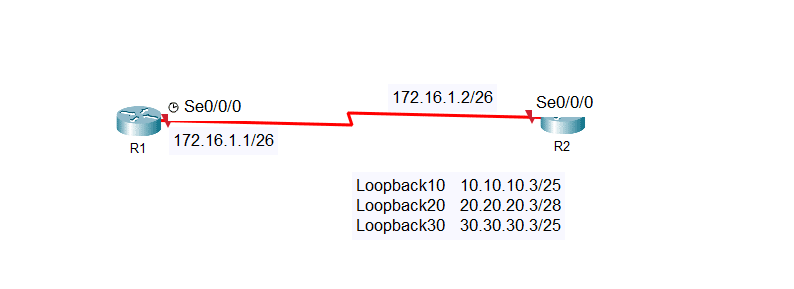configuration, verification and troubleshooting of IPv4 addresses :
Objective of the Lab
The goal of this lab is for you to learn and understand how to create and troubleshoot IPv4 addresses on Cisco routers.
IPv4 addressing configuration is one of your most basic tasks as a network administrator. In the exam, you may also be asked to troubleshoot an IPv4 addressing that has already been configured, but incorrectly! So you need to know which show commands to use.
Topology of the Lab IPv4 configuration
Here is the topology of the Lab:

Task 1:
Configure the host names on routers R1 and R2 as shown in the topology.
Task 2: IPv4 configuration
Configure the IPv4 addresses on the serial interfaces of R1 and R2 as shown in the topology. Also, configure the Loopback interfaces specified in the diagram to R2.
Task 3:
Check the configurations using the show command
- The summary of all IPv4 addresses configured on the ;
- The administrative status of the interfaces (up or down);
- Subnet masks applied to interfaces.
Lab solution
Task 1:
On router R1 R1>enable Router#configure terminal Enter configuration commands, one per line. End with CNTL/Z. Router(config)#hostname R1 R1(config)# Sur le routeur R2 R1>enable Router#configure terminal Enter configuration commands, one per line. End with CNTL/Z. Router(config)#hostname R2 R2(config)#
Task 2:
R1>enable R1#configure terminal Enter configuration commands, one per line. End with CNTL/Z. R1(config)#interface serial 0/0/0 R1(config-if)#ip address 192.16.1.1 255.255.255.192 R1(config-if)#no shutdown %LINK-5-CHANGED: Interface Serial0/0/0, changed state to down R1(config-if)# R2>enable R2#configure terminal Enter configuration commands, one per line. End with CNTL/Z. R2(config)#interface serial 0/0/0 R2(config-if)#ip address 172.16.1.2 255.255.255.192 R2(config-if)#no shutdown R2(config-if)# %LINK-5-CHANGED: Interface Serial0/0/0, changed state to up R2(config-if)#exit R2(config)#interface loopback 10 R2(config-if)# %LINK-5-CHANGED: Interface Loopback10, changed state to up %LINEPROTO-5-UPDOWN: Line protocol on Interface Loopback10, changed state to up R2(config-if)#ip address 10.10.10.3 255.255.255.128 R2(config-if)#no shutdown R2(config-if)#exit R2(config)#interface loopback 20 R2(config-if)# %LINK-5-CHANGED: Interface Loopback20, changed state to up %LINEPROTO-5-UPDOWN: Line protocol on Interface Loopback20, changed state to up R2(config-if)#ip address 20.20.20.3 255.255.255.240 R2(config-if)#no shutdown R2(config-if)#exi R2(config)#interface loopback 30 R2(config-if)# %LINK-5-CHANGED: Interface Loopback30, changed state to up %LINEPROTO-5-UPDOWN: Line protocol on Interface Loopback30, changed state to up R2(config-if)#ip address 30.30.30.3 255.255.255.248 R2(config-if)#no shutdown R2(config-if)#
Task 3:
R2#show ip interface brief Interface IP-Address OK? Method Status Protocol GigabitEthernet0/0 unassigned YES unset administratively down down GigabitEthernet0/1 unassigned YES unset administratively down down GigabitEthernet0/2 unassigned YES unset administratively down down Serial0/0/0 172.16.1.2 YES manual up up Serial0/0/1 unassigned YES unset administratively down down GigabitEthernet0/1/0 unassigned YES unset administratively down down Serial0/2/0 unassigned YES unset administratively down down Serial0/2/1 unassigned YES unset administratively down down GigabitEthernet0/3/0 unassigned YES unset administratively down down Loopback10 10.10.10.3 YES manual up up Loopback20 20.20.20.3 YES manual up up Loopback30 30.30.30.3 YES manual up up Vlan1 unassigned YES unset administratively down down R2#



